
The Boston Public Library is a municipal public library system in Boston, Massachusetts, founded in 1848. The Boston Public Library is also Massachusetts' Library for the Commonwealth, meaning all adult residents of the state are entitled to borrowing and research privileges, and the library receives state funding. The Boston Public Library contains approximately 24 million items, making it the third-largest public library in the United States behind the federal Library of Congress and New York Public Library, which is also privately endowed. The Central Library's McKim building in Copley Square was designated as a Boston Landmark by the Boston Landmarks Commission in 2000.
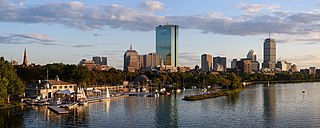
Back Bay is an officially recognized neighborhood of Boston, Massachusetts, built on reclaimed land in the Charles River basin. Construction began in 1859, as the demand for luxury housing exceeded the availability in the city at the time, and the area was fully built by around 1900. It is most famous for its rows of Victorian brownstone homes—considered one of the best preserved examples of 19th-century urban design in the United States—as well as numerous architecturally significant individual buildings, and cultural institutions such as the Boston Public Library, and Boston Architectural College. Initially conceived as a residential-only area, commercial buildings were permitted from around 1890, and Back Bay now features many office buildings, including the John Hancock Tower, Boston's tallest skyscraper. It is also considered a fashionable shopping destination and home to several major hotels.

Park Street Congregational Church, founded in 1809, is a historic and active evangelical congregational church in Downtown Boston, Massachusetts, United States. The Park Street Church is a member of the Conservative Congregational Christian Conference. Church membership records are private, but the congregation has over 1,200 members. The church is located at 1 Park Street, at the corner of Tremont Street.

King's Chapel is an American independent Christian unitarian congregation affiliated with the Unitarian Universalist Association that is "unitarian Christian in theology, Anglican in worship, and congregational in governance." It is housed in what was for a time after the Revolution called the "Stone Chapel", an 18th-century structure at the corner of Tremont Street and School Street in Boston, Massachusetts. The chapel building, completed in 1754, is one of the finest designs of the noted colonial architect Peter Harrison, and was designated a National Historic Landmark in 1960 for its architectural significance. The congregation has worshipped according to a Unitarian version of the Book of Common Prayer since 1785, currently in its ninth edition.
The American Unitarian Association (AUA) was a religious denomination in the United States and Canada, formed by associated Unitarian congregations in 1825. In 1961, it consolidated with the Universalist Church of America to form the Unitarian Universalist Association.
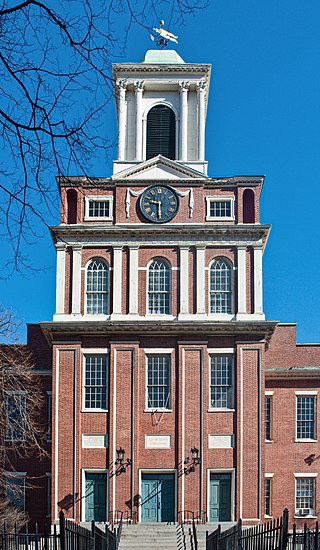
The Old West Church is a historic United Methodist Church at 131 Cambridge Street in the West End of Boston, Massachusetts. It was built in 1806 to designs by architect Asher Benjamin, and is considered one of his finest works. It is a monumentally-scaled example of ecclesiastical Federal architecture, whose design was widely copied throughout New England.
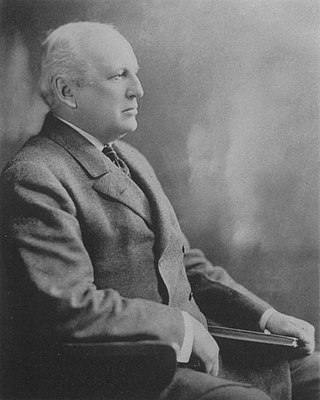
Samuel Atkins Eliot II was an American Unitarian minister. In 1898 the American Unitarian Association elected him secretary but in 1900 the position was redesignated as president and Eliot served in that office from inception to 1927, significantly expanding the association's activities and consolidating denominational power in its administration.

The Lenox Library is the principal public library of Lenox, Massachusetts. It is managed by the non-profit Lenox Library Association, founded in 1856, and is located at 18 Main Street, in the former Berkshire County Courthouse that is listed on the National Register of Historic Places.

The Common District encompasses the main civic center of Wakefield, Massachusetts. It is centered on the historic town common, just south of Lake Quannapowitt, which was laid in 1644, when it became the heart of Old Reading. The area was separated from Reading as South Reading in 1818, and renamed Wakefield in 1868. The 25 acre district includes the buildings that line the common on Common Street and Main Street, which include the town hall, public library, YMCA, post office, and several churches. It was listed on the National Register of Historic Places in 1990.

The Brattle Street Church (1698–1876) was a Congregational and Unitarian church on Brattle Street in Boston, Massachusetts.
The Second Church was a congregation active during 1649–1970, which occupied a number of locations around Boston, Massachusetts. It was first a Congregational church, and then beginning in 1802, a Unitarian church. In 1970, it merged with Boston's First Church.
This article is a timeline of the history of the city of Boston, Massachusetts, US.

Mount Vernon Church in Boston, Massachusetts, was a Congregational church located on Beacon Hill (1844–1891) and later in Back Bay (1892–present).

The Boston Seaman's Friend Society or Seafarer's Friend is a charitable religious organization based in Boston, Massachusetts. It aims to improve the welfare of mariners.

Domingo Mora (1840–1911) was a Spanish-American sculptor and architectural sculptor.

The National Council of Congregational Churches of the United States was a mainline Protestant, Christian denomination in the United States. Its organization as a denomination was delayed by the Civil War. Congregational leaders met again in Boston, Massachusetts in 1865, where they began to hammer out standards of church procedures (polity) and adopted a statement of faith, known as the Burial Hill Declaration. Denominational organization came in 1871 with formation of the National Council of Congregational Churches, which existed until its merger in 1931. In 1928, there were 5,497 Congregational churches in the U.S. with a membership of 939,130. These churches were served by 5,648 ministers.

Congregationalism in the United States consists of Protestant churches in the Reformed tradition that have a congregational form of church government and trace their origins mainly to Puritan settlers of colonial New England. Congregational churches in other parts of the world are often related to these in the United States due to American missionary activities.
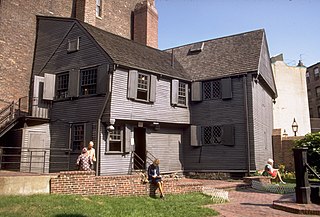
The architecture of Boston is a robust combination of old and new architecture. As one of the oldest cities in North America, Boston, Massachusetts has accumulated buildings and structures ranging from the 17th-century to the present day, having evolved from a small port town to a large cosmopolitan center for education, industry, finance, and technology. The city is known for its granite buildings stemming from its early days. It is also known for being one of the origins of Federal Architecture.
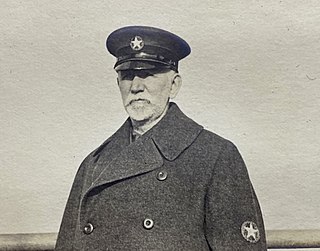
James Levi Barton (1855–1936) was an American Protestant missionary and educator who devoted his life to establishing and administering schools and colleges in the Near East, and overseeing Near East relief efforts before and after World War I. He rose to prominence in the United States and internationally when he was named Chairman of the American Committee for Relief in the Near East, and subsequently the follow-on organization, Near East Relief. He was fluent in Armenian, a prolific writer with numerous books to his name, and the recipient of multiple honorary degrees.





















